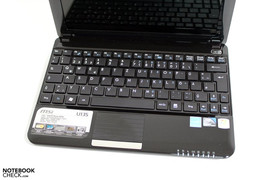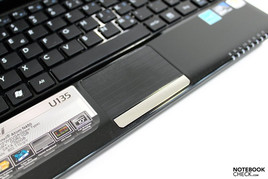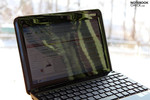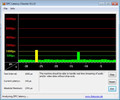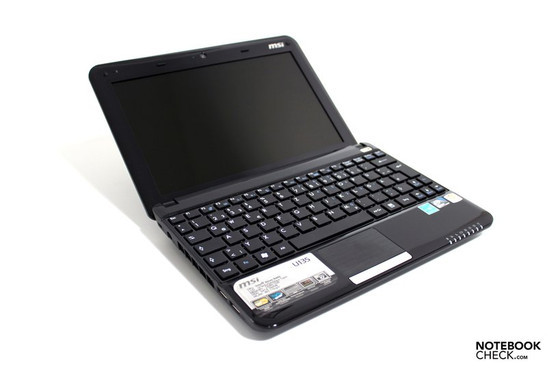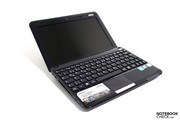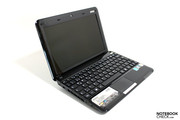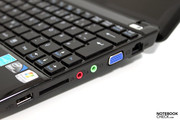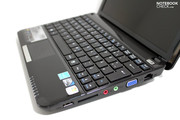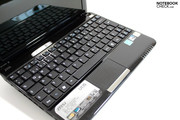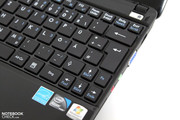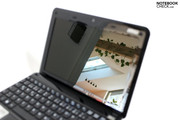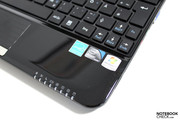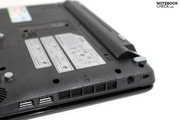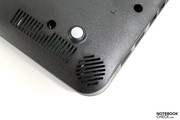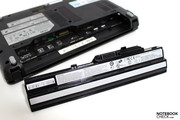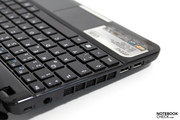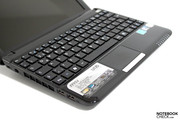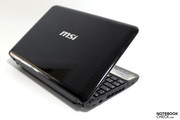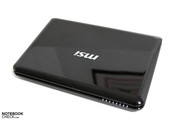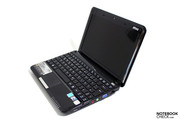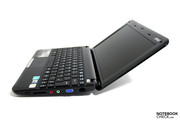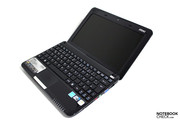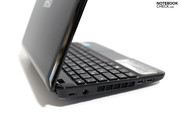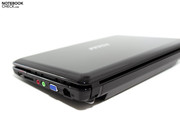Review MSI Wind U135 Netbook
UpWind?
The Wind models were counted to the pioneers of the unyielding netbook trend, beside the Eee PCs from Asus. It's no wonder then, that MSI offers fitting models a short time after the release of Intel's Pine Trail platform. The Wind U135 presents itself as a classic plain netbook at an especially attractive price. The netbook is allegedly available for starting at 299 euro.
The MSI Wind U100 is, or rather was, one of the most popular 10 inch netbooks of the first hour. MSI offered the netbook in several alternatives, among others as a SSD-HDD solution (Wind U115). With Intel's update of its own netbook platform "Pine Trail", there is now reason enough for MSI to refresh its netbook range and to release a few new models. The Wind U135 is one of them and positions itself primarily in the low-priced starter field. Read in the following review if the netbook can benefit from the new, significantly more energy efficient components.
Case
There haven't been any big changes in comparison to the Wind U135's case. The plain forms and the use of plastic remain. The netbook has basically taken a step toward Asus' Eee PC. The case has been dipped completely in high-gloss, with exception of the base tray, and all plastic components in the wrist-rest area will from now on be designed chaste and without any structure. The evidently ever-increasing fashion of chiclet design for the keyboard is also very striking.
MSI presents four different color alternatives online. Aside from our prototype's black design, there will allegedly also be a white, a blue and red outfit offered internationally. However, only the black alternative will be commercialized in Germany.
As pretty as the reflective surfaces may be to look at, everyday use turns out to be even more tedious. In particular, the ugly-to-look-at fingerprints that quickly multiply themselves on the surfaces will turn into a problem. It's almost impossible to handle the netbook without leaving related traces on it. In addition, there is the risk of permanent traces, such as fine scratches due to frequent netbook packing and unpacking.
The MSI U135 doesn't miss a trick in terms of stability. The base unit makes a very solid impression and isn't impressed by selective pressure. The display is also very convincing in this point. It can only be twisted with difficulty, which allows for a picking up of the netbook at its display edge without problems. Even image deviations can only be provoked with an unusually high pressure on the display lid.
Both display hinges have to accept reproach. They pleasantly can be easily adjusted but the display teeters eagerly. Aside from that, we only noticed one further peculiarity: When the display is opened more than 110°, the entire netbook has a strong tendency to fall over towards the back. This is, to a part, especially very annoying during the netbook's mobile use on the lap.
Connectivity
A quick look around the netbook proves that there hasn't really been much changed about the given ports, either. The MSI Wind U135 is just about the same as the U115 based on Intel's Atom in terms of scope and positioning. Summarizing, this means that there are a total of three USB ports in the front area of the left and right side edges, an SD cardreader, microphone and headphone socket, as well as the LAN and VGA port on the right side edge. The front and back remain unfettered from connections.
The range complies with the netbook standard. However, that all USB ports have been placed on the far front sides could possibly turn out to be less supportive. We weren't quite as happy with the VGA port, either. The MSI Wind U135 supports a maximum of 1680x1050 pixels on external monitors. The netbook, tested with our reference monitor Dell 2408 WFp, only provided a sufficient image quality in this resolution. There was a very evident blurriness especially in texts; pictures and videos were still just alright.
The user can also expect the common standards as communication modules with wireless LAN 802.11 b/g/draft-n and Bluetooth V2.1+EDR. MSI builds in a 1.3 megapixel webcam for possible video conferences. If a UMTS version of the netbook will be available is still unknown.
MSI uses Microsoft's Windows 7 Starter Edition as the operating system. The warranty period will add up to the netbook-usual 2 years (pickup & return service). On the official MSI homepage, packages with an own case and a wireless mouse are shown. According to MSI, this should be limited to the international market as well. Merely the netbook without any special supplies can be ordered in Germany.
Keyboard
As already mentioned above, MSI has given the Wind U135's keyboard a chiclet design. With a gaps of about three millimeters between the single keys, which can be very beneficial for especially compact keyboards, typos are to be reduced. Because MSI uses the available case width of around 260 millimeters very well, the typing comfort turns out quite acceptable for a 10 inch netbook.
The keys have a comparatively short stroke length and a very distinct pressure point. The keyboard unit yields slightly under high pressure, but doesn't impair typing. Contrarily, the noise level always stays in an unremarkable field even at fast typing.
The Wind U135 completely omits hot keys. All settings are to be made in combination with the FN key.
Touchpad
MSI regards the touchpad built into the U135 as "wider and more attractive". With a width of 62 millimeters it definitely can be counted to the widescreen inputs and the slightly roughened surface complies with our idea of a user-friendly pad. Because there weren't any problems in terms of response behavior, there's nothing speaking against using the pad as a mobile mouse substitute. We didn't notice multi-touch support just as little as a horizontal or vertical scroll area.
Display
MSI builds in a 10.1 inch WSVGA screen with an LED light, to be more precise a Hannstar HSD100IFW1 unit in our prototype. The maximum available resolution adds up to 1024x600 pixels. You'll have to count with the displayed image being cut on the right edge, especially when surfing in the web or even in many office applications. It was even more annoying that, at least in our prototype, the needed scroll function didn't work or wasn't enabled.
The display could make an overall positive impression in the technical measurements. Thus, the screen had a good maximum brightness in the range of 182 to 217 cd/m2 at an, equally adequate, illumination of 84%.
| |||||||||||||||||||||||||
Brightness Distribution: 84 %
Center on Battery: 214 cd/m²
Contrast: 892:1 (Black: 0.24 cd/m²)
The used image display device scored perfectly in terms of the maximum possible contrast. The screen achieves a maximum possible ratio of 892:1 in the center display area with an especially low black value of only 0.24 cd/m2 - that's just about as good as it can get. The screen subjectively makes a good impression even at rendering pictures. They gleam in intensive colors on the display.
As experience has shown, one point that annoys us in almost every mobile consumer device is the built-in glare type display. Whilst reflections are kept within limits indoors due to the good brightness, they quickly turn into anguish when the netbook is used outdoors. It's recommendable to consider the position to the sun and if required, to look for a shadowy place.
The given viewing angles turn out surprisingly generous for a netbook. As the picture almost remains unchanged in the optimal perpendicular viewing position ("only" reflections impair the representation), you can also take delight in an unusually large stable viewing area on the vertical plane. This reduces the necessary display inclination adjustments to a minimum.
Performance
Of course, in the first test of the new Intel range with the sounding name "Pine Trail" in Asus Eee PC 1005p, the big question was to be answered: To what extent will the new technology contribute a performance gain for the upcoming netbook generation? Unfortunately, various hopes of a performance increase couldn't be fulfilled. But there are advantages in power consumption, whereby the Pine Trail range proves to be considerably more sparing in comparison to the old "Diamondville".
The new Intel Atom N450 CPU with 1.66 GHz now also accommodates the graphic chip labeled GMA 3150 and the memory controller. Intel could reduce the power requirement considerably with these and other measurements, as can be seen clearly in the single TDP-key figures (Thermal Design Power) of 2W for the new Intel NM 10 chip set and a whole 22W for the older Intel 945GC chip set. At the same time, the Atom N450 chip's TDP increased to 5.5W in comparison to the 2.5W of the N280 CPU. Overall, an immense savings advantage remains anyway.
Asus' 1005p scores a bit better in the direct SuperPi benchmark comparison. The Eee is always a few seconds faster in each runthrough, which however can't really be determined subjectively in the performance of both netbooks. Asus' integrated overclocking function is responsible for the 1005's slight advantage (+50p) that the MSI counterpart doesn't have.
It looks the same in the 3D benchmark test, 3DMark2001. The MSI stays a bit behind the Asus 1005p with 2769 points. There aren't any performance gains to be counted with in comparison to the old GMA 950 graphic solution, as more precise tests with the Eee PC have shown.
Therefore, the MSI Wind U135's application field can be described alike the previous netbook range: Simple office applications, internet and mail. Depending on the application, there are partly longer waiting periods that have to be accepted than in average dual-core notebooks, which is especially the case when managing several applications at once. If watching high resolution videos is of special interest, Ion ranges should be favored as the integrated Geforce 9400M G graphic card can support the Atom CPU significantly here.
Checking the system latencies showed deflections in the possibly critical field every now and again. It can, therefore, come to synchronization problems when external devices (soundcards) are connected. Usually single drivers (e.g. WLAN) are fault that can be repaired by disabling or updating it.
| 3DMark 2001SE Standard | 2446 points | |
| 3DMark 03 Standard | 692 points | |
Help | ||
A system memory from Fujitsu (MJA2250BH G2) was used in our prototype, which has with a gross capacity of 250 GB and rotates with 5400 rpm. The 2.5 inch HDD presented good transfer rates in the HDTune test and an average access rate of 18.7 milliseconds. Merely the CPU use turned out a bit high with 8.1%.
Emissions
System Noise
Basically, the hardware component development (considerably lower TDP) would also lead to a lower system noise, as there is a lot less potential waste heat. The MSI Wind U135 seems not to be able to translate this, as it can be observed, and above all heard, that the fan runs permanently even without load. It isn't obtrusive with 34.5 dB(A) but perpetually present anyway and can get unpleasant especially in a very quiet environment in time.
It's especially baffling that the waste air is only moderately tempered and a significantly lower fan revolution would probably also supply a sufficient cooling. The Asus 1005p is much more capable of this and stays quiet with a bit over 30 dB(A) in idle mode.
Noise level
| Idle |
| 34.1 / 34.5 / 35.2 dB(A) |
| HDD |
| 34.9 dB(A) |
| Load |
| 39.2 / 41.3 dB(A) |
 | ||
30 dB silent 40 dB(A) audible 50 dB(A) loud |
||
min: | ||
Temperature
If there now were suspicious case surface temperatures noticed, something would likely be badly wrong with the prototype. The recorded, practically barely existent, heating of the single measured areas of under 30°C fit well into the picture with the always present fan, though.
In our opinion, it would be very sensible to basically decrease the volume at the expense of a few degrees more case temperature. Changes in fan control can be made, as experience shows, via a simple driver update and is therefore possible until sales launch and also afterwards. We'll have to wait and see if MSI makes improvements.
(+) The maximum temperature on the upper side is 29.1 °C / 84 F, compared to the average of 33.1 °C / 92 F, ranging from 21.6 to 53.2 °C for the class Netbook.
(+) The bottom heats up to a maximum of 29.1 °C / 84 F, compared to the average of 36.6 °C / 98 F
(+) In idle usage, the average temperature for the upper side is 26.2 °C / 79 F, compared to the device average of 29.8 °C / 86 F.
(+) The palmrests and touchpad are cooler than skin temperature with a maximum of 28.8 °C / 83.8 F and are therefore cool to the touch.
(±) The average temperature of the palmrest area of similar devices was 29.3 °C / 84.7 F (+0.5 °C / 0.9 F).
Loudspeakers
MSI builds in two little squeakers on the base unit's bottom left and right front corner. Our verdict about this turns out very feeble. The maximum volume is restricted, the sound everything else than worth hearing. The trebles are much too dominant even at a reduced volume and sound enjoyment can't be found at any setting.
The audio signal's output over the headphone socket turns out a lot better, even if the exact opposite in terms of sound (way too muffled, subjectively). If appropriate external speakers are attached (active), then at least a reasonable music enjoyment should be within the realms of possibility.
Battery Life
The Wind U135 tries to score in terms of mobility with a lithium ion battery with a capacity of 49Wh. MSI itself states a runtime of up to 7.5 hours. The Wind U135 almost achieves the manfacturer's stated top value of 420 minutes or 7 hours in the BatteryEater Reader's test, representative of the maximum runtime at reading a document (energy saving mode, min. display brightness, WLAN disabled).
The other extreme, that is to say the minimum possible battery life under load (max. display brightness, profile high performance, WLAN+BT enabled) is checked with the BatteryEater Classic test, as usual. Our prototype reaches an equally satisfactory battery runtime of 213 minutes here.
We could record a runtime of about 350 minutes in the practical WLAN test with maximum display brightness and enabled energy savings profile.
A considerably lower battery life in all areas is noticed when comparing the achieved results with those of the Asus Eee 1005p, and that at an almost equal battery capacity (1005p:48Wh). So, the reason can actually only be found in the power consumption.
The MSI Wind U135 has a minimum of 6.3W with the lowest possible energy savings options. The Asus is much lower with 4.6W. This also applies to the idle mode with maximum display brightness, where the MSI Wind U135 consumes a maximum of 9.5W and the Asus 1005p once again needs about 30% less energy with 6.6W. A possible reason for this is certainly the display that shines considerably brighter with over 200 cd/m2 in the MSI Wind than in the Asus with only a bit over 100 cd/m2.
The difference of around 30% runs further up to the maximum power consumption under load, where the ratio of 16.7 to 12 W also advocates Asus.
MSI's quoted "Turbo Battery Mode" couldn't be identified. You find a correlating icon by the function keys, but pressing neither triggered an optical feedback nor was there a noticeable impact on the hardware, such as the CPU clock rate.
| Off / Standby | |
| Idle | |
| Load |
|
Key:
min: | |
Verdict
"The best design offers ultimate ease and joy." - is what MSI's Chief Industrial Designer is said to have stated in connection with the Wind U135. Well, we can basically verify the simplicity of handling the netbook, but joy on design is an issue as such. Our black prototype's great tendency to smudge smothers the initial exhilaration very quickly, in our opinion. Furthermore, there is glare type display that principally shows respectable assessment data, but is at a disadvantage in adverse light conditions in comparison to displays with a matt surface.
It's necessary to remark the good case stability as well as the very pleasant to use keyboard.
You get the usual Wind fare that correlates to the positioning in the netbook sector in terms of connectivity. This also applies to the netbooks performance, despite brand new Intel hardware. The Intel N450 CPU with the GMA 3150 graphic chip places itself on the same level as its predecessors (N280/GMA950) but has the advantage of a significantly lower power consumption.
The Wind U135 reaches up to 7 hours in the battery test. This is a feasible rate but still lags far behind the identically equipped Asus Eee 1005p. The netbook's soundscape, in particular the always present fan, could be an issue for sensitive ears. The price will likely also be decisive for the Wind U135's success, which is estimated at less than 300 euro, according to first information. A serious competitor, the Asus Eee 1005p, with a street price on about the same level is already being sold.







